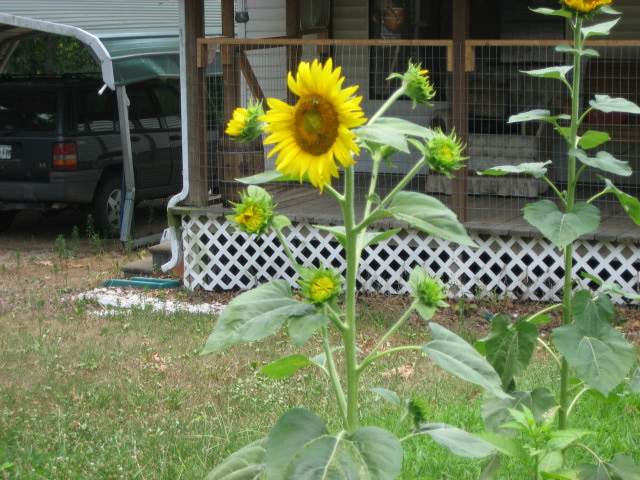Question
 sunflower
sunflower
Have you ever seen a sunflower like this one with lots of flowers?
AnswerEvery once in a while, someone with a branching Sunflower writes in with this question. Because I don't know everything, I look into it. We learn something new about Sunflowers every day. And over the years, I've seen all kinds of explanations: Herbicide drift. Genetic damage from some environmental mishap. Pests. Overwatering, underwatering, and on and on.
I have two theories.
1. The seed pack contained one or more seeds mixed in by mistake at the factory.
OR (and this is my favorite theory)
2. You have a Sunflower with renegade DNA -- a mysterious mutation that botanists call a 'sport.' Because Mammoth Sunflowers, which I think is what you have there, are one of those plants that simply does not grow more than one flower per stem... 90 percent of the time.
Consider, now, that we are witnessing genetic variability in nature all around us. Entire books have been written about the factors affecting genetic change and frequency. Just try keeping up with the literature. Once a book about genetics is on the shelf, it's already out of date.
Studies of what amounts to Sunflower evolution being conducted as we speak at North Dakota State University, where one scientist is delving into "Molecular mapping of an apical branching gene of cultivated Sunflower." Or Rice University and Kansas State, where they examine things like 'Long Terminal Repeat retrotransposons' and the 'dynamics of proliferation events of Ty3/gypsy-like LTR retrotransposons that led to massive genomic expansion in three Helianthus,' the scientific name for Sunflower.
Driving the scramble to understand this plant is its enormous economic value. There's a huge market for sunflower oil, sunflower seeds, and of course the plants and flower stems. Plus birds love them.
Plant catalogs are filled with sports of popular hybrids. A field of daffodil 'Actaea' Narcissus produced the sport called 'Green Pearl'; 'Obdam' Narcissus is a sport of 'Ice Follies'.
But in the summer of 2012, Theory #1 may not be so far fetched. Sherry Rindels, who writes for the Department of Horticulture at Iowa State, pointed out in 1996: "There are some 67 species within the Helianthus genus... In the last 10 years, three new types of sunflowers have been introduced into the North American market. The first new type has a sturdy central stem that produces multiple branches with many flowers. The result is a showy garden plant that is excellent for cutting. Staking is not required..."
Here's the link:
http://www.ipm.iastate.edu/ipm/hortnews/1996/4-26-1996/sunny.html
So it is indeed entirely possible that a few stray seeds of Choco Sun, or Ebony & Gold, which did not exist just a few years ago in the commercial trade.
Or perhaps you are the unwitting accomplice to a genetic twist -- a 'sport' -- in your own backyard.
That would be so cool.
THE LONG ISLAND GARDENER






